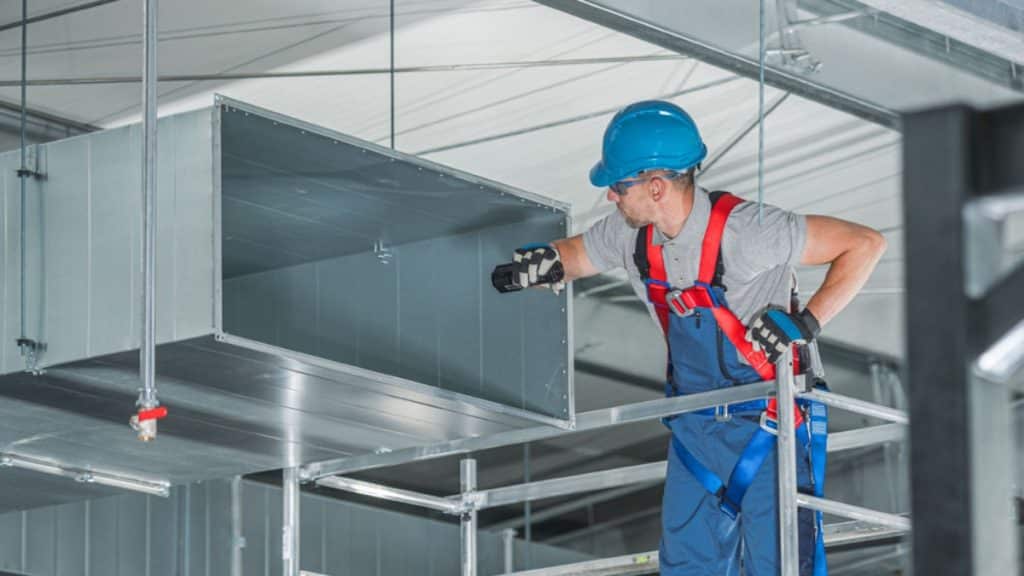A heating, ventilation and air-conditioning (HVAC) has the sole function of creating and sustaining a pleasant, practical climate. This involves managing temperature as well as guaranteeing good ventilation. In commercial settings, where spaces are more expansive and foot traffic is increased, specialist high-capacity equipment is needed.

The world of HVAC supply can be a little confusing to the unfamiliar, though it’s simple enough to learn the basics. When you understand how this essential kit works, you better appreciate the distinctions between the various designs and components.
By getting to grips with your HVAC system, you can make wiser decisions on not only the types of unit best for your business, but also the operating and maintenance practises that save you money in the long-term.
What is a Commercial HVAC System?
While a home air-conditioning (AC) unit is tasked with cooling your residence, HVAC systems deal with cooling and heating the air. Beyond this, there are residential and commercial HVAC systems, both of which are supplied and installed by Baikal Mechanical.
Generally speaking, the size and scale of a HVAC system mirrors the environment they’re in, meaning that residential examples are typically smaller with limited capability. In contrast, commercial HVAC systems must keep up with very demanding workloads, often running indefinitely, thus they are more complicated and powerful.
Another distinction is that commercial systems are far more adaptable because they’re modular, which applies to practically all HVAC components. Not only is this far more convenient for HVAC parts supply, companies essentially create the structures works best for their particular situation, including managing multiple climates (zones) in the same building.
How does a Commercial HVAC System work?
The simplest explanation is that HVAC systems move air. How the air is treated and directed depends on whether you’re heating or cooling your space, which is signalled by the thermostat.
To warm the environment, the furnace (burner) raises the temperature of the heat exchanger, which the air then passes over before it’s distributed through the ducts. To cool the space, a HVAC compressor and condenser coil turns refrigerant from gas to liquid, which drastically chills the blown air.
Even though one building’s commercial HVAC system can vary greatly from the next, the fundamental method of moving and treating air is largely the same.
Types of Commercial HVAC System
Commercial models can be split into common types, namely:
1. Split HVAC Systems
A split HVAC system uses internal units, involving furnace and coil, and external units, involving a heat pump or air-conditioner. The refrigerant evaporates and condenses through these two blocks in order to transfer heat.
As the most affordable option, this solution is ideal for smaller businesses like shops and cafes. Assuming you have the interior and exterior space necessary, a split HVAC system allows to add new units to accommodate your expanding business.
Each of these internal-external pairs operate independently, so any breakdown will be isolated. Consequently, Baikal Mechanical engineers can quickly diagnose and resolve any issue with minimal inconvenience and cost to you and your business.
2. CAV and VAV Systems
Constant air volume (CAV) models maintain constant air flow but adjust temperatures. This type of HVAC is great for single-zone situations because the fan and compressor run constantly until the thermostat temperature is met, after which they automatically shut off.
Conversely, variable air volume (VAV) maintain constant temperature, but adjust flow. In essence, the regulation of coolant and compressor maintains a steady temperature whilst a variable-speed fan controls volumes of air. Both CAV and VAV systems are single-duct supply and return arrangements.
3. VRV/VRF Systems
Variable Refrigerant Volume (VRV) systems, also known by Variable Refrigerant Flow (VRF), are the superior option for larger commercial spaces. In such a design, refrigerant is the only cooling influence, so there’s no chillers or coils.
These systems either use heat pumps for cooling and heating, or more sophisticated heat recovery for managing multiple zones at different temperatures. With inverter compressor technology, the motor runs at variable speeds and is thus more efficient/cost-effective.
Which HVAC System is best?
The HVAC system that best matches your business depends on the space parameters, how your business operates, and of course your personal preferences. Just as HVAC systems vary in their capabilities, so too do they differ in running and maintenance costs.
The type of HVAC system you choose has huge implications, including the time it takes to see return on your investment. With such a significant consideration, it’s important to ensure you’re working with HVAC engineers that have your best interests in mind.
Baikal Mechanical is committed to top-quality equipment that requires minimal maintenance. We’re perfectly aware of the fact that business owners are constantly balancing performance and cost, which is why we help you build a commercial HVAC system for your specific needs.
